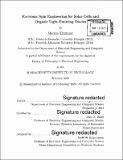| dc.contributor.advisor | Marc A. Baldo. | en_US |
| dc.contributor.author | Einzinger, Markus. | en_US |
| dc.contributor.other | Massachusetts Institute of Technology. Department of Electrical Engineering and Computer Science. | en_US |
| dc.date.accessioned | 2020-11-06T21:08:32Z | |
| dc.date.available | 2020-11-06T21:08:32Z | |
| dc.date.copyright | 2020 | en_US |
| dc.date.issued | 2020 | en_US |
| dc.identifier.uri | https://hdl.handle.net/1721.1/128410 | |
| dc.description | Thesis: Ph. D., Massachusetts Institute of Technology, Department of Electrical Engineering and Computer Science, 2020 | en_US |
| dc.description | Cataloged from PDF of thesis. | en_US |
| dc.description | Includes bibliographical references (pages 133-147). | en_US |
| dc.description.abstract | The last two decades have seen renewed interest in molecular organic semiconductors. Since these materials support the formation of excitons, their behavior differs considerably from their inorganic counterparts. This gives rise to a variety of novel properties that can be exploited to create entirely new or improve existing optoelectronic devices. In this thesis, we explore excitonic concepts for improving both organic-light emitting diodes (OLEDs) and silicon solar cells. OLEDs are already commercially successful. However they still suffer from several major drawbacks. Multiexcited-state phenomena are believed to be the root cause of challenges like efficiency roll-off and degradation. The development of novel strategies to reduce exciton densities under heavy load is therefore highly desirable. | en_US |
| dc.description.abstract | In this thesis, it is shown that triplet exciton lifetimes of thermally activated delayed fluorescence (TADF) emitter molecules can be manipulated in the solid state by exploiting intermolecular interactions. The external heavy-atom effect of brominated host molecules leads to increased spin-orbit coupling, which in turn enhances intersystem crossing rates in the guest molecule. Shorter triplet exciton lifetimes are observed, while high photoluminescence quantum yields (PLQYs) are maintained and emission spectra are essentially unaltered. A change in the intersystem crossing rate ratio due to increased dielectric constants leads to almost 50% lower triplet exciton densities in the emissive layer in the steady state and results in an improved onset of the PLQY roll-off at high excitation densities. Efficient OLEDs with better roll-off behavior based on these novel hosts are fabricated, demonstrating the suitability of this concept for real-world applications. | en_US |
| dc.description.abstract | In addition, efficient and stable blue emitters for OLEDs are urgently needed for next-generation display and lighting applications. This thesis presents a tunable series of TADF emitter molecules. After pairing the iminodibenzyl donor with the triazine acceptor via a phenylene linker, dihedral angle tuning is employed to regulate the difference between the energy levels of singlet and triplet excited states. Enhanced reverse intersystem crossing rates are observed in response to increased methylation at the phenylene linker. PLQYs of up to 98% are achieved upon doping into a solid-state matrix. When incorporated in devices, the maximum external quantum efficiency is 28.3% for the emitter with the most favorable trade-off between singlet-triplet splitting and fluorescent oscillator strength. | en_US |
| dc.description.abstract | This result highlights the general applicability of dihedral angle tuning, a molecular design strategy that can be used to improve the performance of donor-acceptor type TADF emitters without significantly changing their emission spectra. In contrast, contemporary solar cell technologies are dominated by silicon, an inorganic semiconductor. But when absorbing photons, silicon (like other semiconductors) wastes energy in excess of its bandgap. Reducing these thermalization losses is possible by sensitizing the silicon solar cell using singlet fission, a carrier multiplication phenomenon that occurs only in organic semiconductors. In this process, two triplet excitons are generated from a singlet exciton. In tetracene, those triplet excitons are energetically matched to the silicon bandgap. Transferring triplet excitons to silicon creates additional electron-hole pairs, promising to increase cell efficiencies from the single-junction limit of 29% to as high as 35%. | en_US |
| dc.description.abstract | In this thesis we reduce the thickness of the protective hafnium oxynitride layer at the surface of a silicon solar cell to just eight angstroms, using electric-field-effect passivation to enable the efficient energy transfer of triplet excitons formed in tetracene. The maximum combined yield of the fission in tetracene and the energy transfer to silicon is around 133%. The processes at the interface are investigated using photoluminescent and magnetic field effect experiments, revealing the impact of different interlayer thicknesses. Finally, the thesis presents the first example of a singlet-fission-enhanced silicon solar cell, a breakthrough that establishes the potential of singlet exciton fission to increase the efficiencies of silicon solar cells and reduce the cost of the energy that they generate. | en_US |
| dc.description.statementofresponsibility | by Markus Einzinger. | en_US |
| dc.format.extent | 151 pages | en_US |
| dc.language.iso | eng | en_US |
| dc.publisher | Massachusetts Institute of Technology | en_US |
| dc.rights | MIT theses may be protected by copyright. Please reuse MIT thesis content according to the MIT Libraries Permissions Policy, which is available through the URL provided. | en_US |
| dc.rights.uri | http://dspace.mit.edu/handle/1721.1/7582 | en_US |
| dc.subject | Electrical Engineering and Computer Science. | en_US |
| dc.title | Excitonic spin engineering for solar cells and organic light-emitting diodes | en_US |
| dc.type | Thesis | en_US |
| dc.description.degree | Ph. D. | en_US |
| dc.contributor.department | Massachusetts Institute of Technology. Department of Electrical Engineering and Computer Science | en_US |
| dc.identifier.oclc | 1202816461 | en_US |
| dc.description.collection | Ph.D. Massachusetts Institute of Technology, Department of Electrical Engineering and Computer Science | en_US |
| dspace.imported | 2020-11-06T21:08:31Z | en_US |
| mit.thesis.degree | Doctoral | en_US |
| mit.thesis.department | EECS | en_US |
